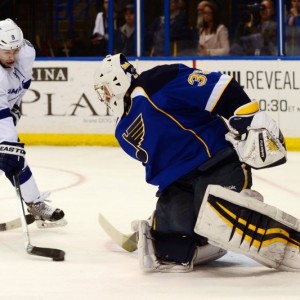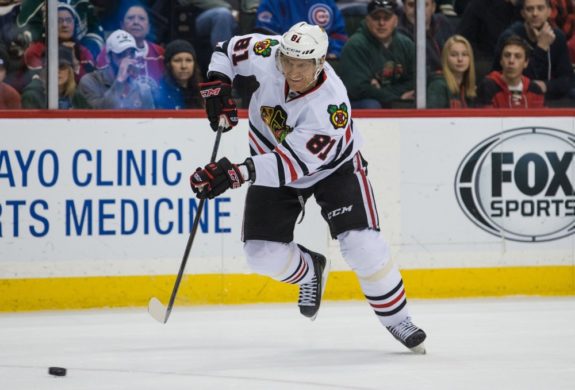There is one date that spans across all four major North American sports and captures the attention of every sports fan: the trade deadline. Major League Baseball’s trade deadline, on July 31st, was dominated by Canada’s team, the Toronto Blue Jays. In an effort to end their long playoff drought, the Blue Jays traded their top prospect in exchange for all-star pitcher David Price, despite Price playing on an expiring contract.
The NHL’s annual trade deadline happens every year on the last Monday of February. Much like the Blue Jays, teams scramble in frantic measures in order to load up their team for the upcoming stretch run and playoffs. Whether it be a team in first place looking to fill holes, or a team on the outside looking in attempting to make a splash and give their team a boost, no trade deadline goes by without big names changing addresses.
When teams go “all-in” by trading future considerations such as prospects and draft picks for established veteran players, who wins? Every team’s ultimate goal is to win the Stanley Cup, and making deals to augment their rosters is often a huge ingredient to a championship recipe. Here are a few of the biggest trade deadline deals from the recent past, attempting to make sense of the trade for both teams and my take on which side won each trade.
To narrow down the huge list of trades made at every deadline, the players involved in the swap must have included an important contributor, the team trading for the “rental” player must have advanced past the first round of the playoffs, and the rental player had to have departed in free agency.
2015 – Chicago acquires Antoine Vermette for 2015 1st round pick and Klas Dahlbeck

On February 28th, 2015, the Chicago Blackhawks traded their first round selection in 2015 and 23 year old defenseman Klas Dahlbeck to the Arizona Coyotes for veteran centre Antoine Vermette. Vermette, who had 35 points in 63 games at the time of the trade, provided much-needed centre and scoring depth to a Hawks team that had just lost superstar Patrick Kane to a broken collarbone for the remainder of the regular season.
For the Coyotes, the logic behind this trade was simple. Arizona sat in 29th in the NHL standings, and with Vermette an upcoming free agent, looked to add youth and draft picks to their roster by moving the highly-coveted 32 year old forward. In Dahlbeck, the team added a young defender with good size (6’3″, 210 lbs) who had put up a strong performance the season before with Chicago’s AHL affiliate. With the first round pick the team acquired, the Coyotes were able to snap up dynamic forward Nick Merkley 30th overall.
The Blackhawks, who were rolling out Brad Richards and Andrew Shaw at centre behind captain Jonathan Toews, desperately needed to add scoring punch to a forward corps that had just lost leading scorer Patrick Kane. While Vermette didn’t produce much in the regular season, tallying just three points in 19 games with Chicago, he was an integral part of the Blackhawks’ run to the Stanley Cup championship. Despite being deployed for less than 15 minutes per game, he scored 3 game winning goals in the playoffs, including the dagger in game 5 of the Cup finals against the Tampa Bay Lightning.
While Chicago passed on adding a skilled forward like Merkley to their ranks, it’s hard to argue with the acquisition of a player that played such an important role in Chicago’s Stanley Cup victory. In this case, adding a rental player worked out for Chicago, as it’s difficult to see the Blackhawks winning the Stanley Cup without Vermette’s timely playoff goal scoring.
2014 – St. Louis acquires Ryan Miller and Steve Ott for Jaroslav Halak, Chris Stewart, William Carrier, and 1st- and 3rd-round picks

The St. Louis Blues have been one of the most successful regular-season teams in the NHL the past few seasons, but two division championships in four seasons and three consecutive 100-point seasons haven’t led to much playoff success for St. Louis. In the past four seasons, the Blues have won just one playoff series, beating the Sharks in 5 games before being swept by the Kings in 2012.
In 2014, the Blues, sitting comfortably in a playoff spot, made a move to acquire the supposedly elite goalie they thought they needed, trading a three player package to the Sabres in order to acquire former Olympic MVP Ryan Miller. At the time of the trade, adding a goaltender with a reputation as good as Miller’s looked to be the move that finally put the Blues over the top, as they were firing on all cylinders and gunning for the President’s trophy.
The move didn’t pay off the way Chicago’s move for Vermette did, however, as the Blues were eliminated in the first round (by the Blackhawks, of all teams), and Miller chose to sign a three-year contract with the Vancouver Canucks in the offseason. Despite his strong reputation, Miller didn’t do much to help the Blues over the hump, as he posted a save percentage of just .903 in 19 regular season games, and a .897 in six playoff games.
For the Sabres, the move to deal away their longtime starting goaltender and franchise cornerstone made sense, as they were sitting in last place and had already traded away several NHL players in hopes of kick-starting their rebuilding phase. Trading away a goaltender as talented as Miller helped net them another starting goalie in Jaroslav Halak (later dealt to Washington), a couple talented forwards with question marks in Chris Stewart and William Carrier, and two draft picks in 2015 and 2016. Stewart was traded for a second-round pick in 2017, while Carrier is still developing his game in the Sabres’ organization and looks poised to take a big step forward in his second AHL season. The Blues’ first round pick was used by the Sabres to acquire young winger Evander Kane, and he looks to be a big part of the Sabres turnaround alongside 2015 2nd overall pick Jack Eichel.
2008 – Pittsburgh acquires Marian Hossa and Pascal Dupuis, for Colby Armstrong, Erik Christensen, Angelo Esposito and 2008 1st-round pick

The Penguins, led by rising superstars Sidney Crosby and Evgeni Malkin, were coming off their first playoff appearance in five years, ending the 2006-2007 season with a first-round loss to the Ottawa Senators. With Crosby sitting out with a high ankle sprain, Pittsburgh traded three young players and a first round pick to the last-place Atlanta Thrashers for the all-star forward Hossa and Pascal Dupuis, a depth forward with only 10 goals on the season.
The Thrashers, sitting near the bottom of the standings after sneaking into the playoffs a season prior, had had contract discussions with their star forward Hossa but had failed to reach an agreement. Fearing he would leave for nothing in free agency, they sold him to the highest bidder, securing another first round pick in addition to strengthening their bid for a high pick in the 2008 NHL Draft.
In Colby Armstrong, they got a popular young player who had a breakout season as Crosby’s wingman in 2006 but had failed to live up to expectations in 2007. Armstrong struggled in Atlanta, only playing two full seasons before moving on. Erik Christensen was another young forward whose scoring had not yet found him in the NHL, but was only 24 with a lot of talent. He was traded the next season and now finds himself out of the NHL. Angelo Esposito was a highly-regarded prospect, the Penguins’ first-round pick in 2007, but struggled with injuries and never made the impact in the NHL that many had predicted he would have. The 2008 first-round pick was used on Daultan Leveille, who has yet to crack an NHL lineup.
The Penguins were pushing to be competitive after wunderkind Crosby had led them from worst to first a season before, and adding Hossa to a forward corps that already had Evgeni Malkin and Jordan Staal was too enticing to pass up. Hossa was injured shortly after being acquired, and therefore tallied only 10 points in the remainder of the regular season for the Penguins. In the playoffs, however, Hossa added 26 points in 20 games to lead the Penguins to the Stanley Cup Final before losing to the Red Wings. Hossa left in free agency after the season to sign with Detroit, ending his Pittsburgh tenure after just 32 games. Dupuis, considered a mere throw-in at the time of the trade, has developed into a fantastic player for Pittsburgh, scoring 109 goals and 243 points since moving to the Steel City.
While Pittsburgh’s addition of Hossa didn’t lead to a Stanley Cup championship in 2008, the Penguins came back stronger than ever in 2009, capturing Sid the Kid’s first Stanley Cup. Hossa provided the scoring punch the Penguins desired at the time of the trade, but the real catch for the Penguins has been Dupuis. He has been an effective top-six forward for the Penguins, providing Sidney Crosby with a reliable winger for several seasons.